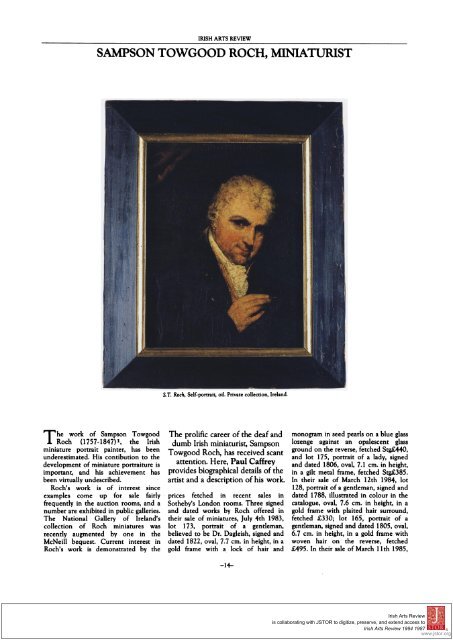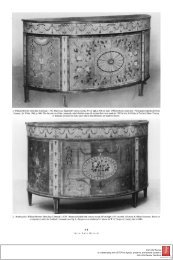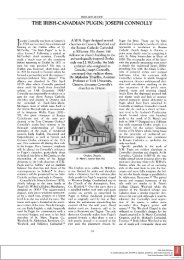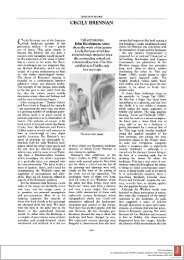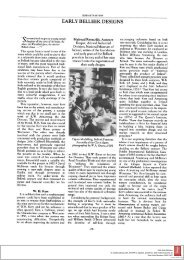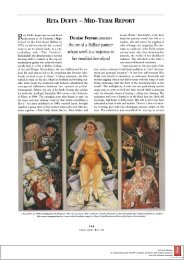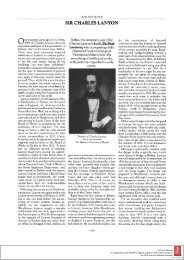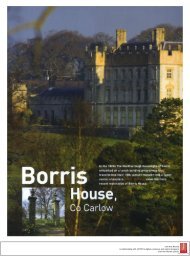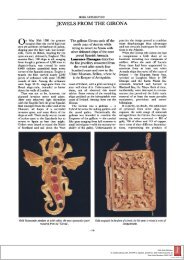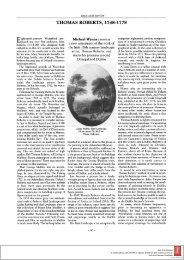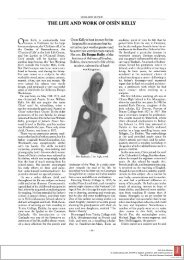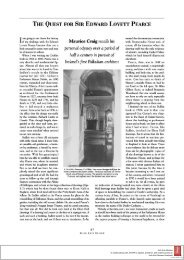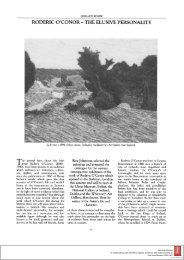SAMPSON TOWGOOD ROCH, MINIATURIST
SAMPSON TOWGOOD ROCH, MINIATURIST
SAMPSON TOWGOOD ROCH, MINIATURIST
You also want an ePaper? Increase the reach of your titles
YUMPU automatically turns print PDFs into web optimized ePapers that Google loves.
_IRISH ARTS REVIEW_<br />
<strong>SAMPSON</strong> <strong>TOWGOOD</strong> <strong>ROCH</strong>, <strong>MINIATURIST</strong><br />
ST. Rock, Self-portrait, oil. Private collection, Ireland.<br />
The<br />
work of Sampson Towgood<br />
Roch (1757-1847) *, the Irish<br />
miniature portrait painter, has been<br />
underestimated. His contibution to the<br />
development of miniature portraiture is<br />
important, and his achievement has<br />
been virtually undescribed.<br />
Roch's work is of interest since<br />
examples come up for sale fairly<br />
frequently in the auction rooms, and a<br />
number are exhibited in public galleries.<br />
The National Gallery of Ireland's<br />
collection of Roch miniatures was<br />
recently augmented by one in the<br />
McNeill bequest. Current interest in<br />
Roch's work is demonstrated by the<br />
The prolific career of the deaf and<br />
dumb Irish miniaturist, Sampson<br />
Towgood Roch, has received scant<br />
attention. Here, Paul Caffrey<br />
provides biographical details of the<br />
artist and a description of his work.<br />
prices fetched in recent sales in<br />
Sotheby's London rooms. Three signed<br />
and dated works by Roch offered in<br />
their sale of miniatures, July 4th 1983,<br />
lot 173, portrait of a gentleman,<br />
believed to be Dr. Dagleish, signed and<br />
dated 1822, oval, 7.7 cm. in height, in a<br />
gold frame with a lock of hair and<br />
monogram in seed pearls on a blue glass<br />
lozenge against an opalescent glass<br />
ground on the reverse, fetched Stg?440,<br />
and lot 175, portrait of a lady, signed<br />
and dated 1806, oval, 7.1 cm. in height,<br />
in a gilt metal frame, fetched Stg?385.<br />
In their sale of March 12th 1984, lot<br />
128, portrait of a gentleman, signed and<br />
dated 1788, illustrated in colour in the<br />
catalogue, oval, 7.6 cm. in height, in a<br />
gold frame with plaited hair surround,<br />
fetched ?330; lot 165, portrait of a<br />
gentleman, signed and dated 1805, oval,<br />
6.7 cm. in height, in a gold frame with<br />
woven hair on the reverse, fetched<br />
?495. In their sale of March 11th 1985,<br />
-14<br />
Irish Arts Review<br />
is collaborating with JSTOR to digitize, preserve, and extend access to<br />
Irish Arts Review 1984 1987 ®<br />
www.jstor.org
Reverse of a miniature<br />
with<br />
locks of hair<br />
The 1st Earl of Charlemont (1786)<br />
Lady Gwendoline Spencer,<br />
signed and dated 1788<br />
Admiral<br />
Fellowes<br />
Venus<br />
at her toilet<br />
Photographs,<br />
George Mott
IRISH ARTS REVIEW<br />
<strong>SAMPSON</strong> <strong>TOWGOOD</strong> <strong>ROCH</strong>, <strong>MINIATURIST</strong><br />
lot 214, portrait of a gentleman, signed<br />
and dated 1797, oval, 6.7 cm. in height,<br />
in a gold frame with monogram on an<br />
opalescent glass ground with a blue glass<br />
surround on the reverse, fetched ?418,<br />
while the pair of miniatures of Mr. and<br />
Mrs. Michael Milner, one signed and<br />
dated 1792, the other dated 1799, each<br />
oval, 6 cm. in height, fetched ?308.<br />
It will be apparent that Roch's life,<br />
covering as it does, the high period of<br />
Irish miniature painting, 1770-1830,<br />
raises two broad paradoxes about the<br />
history of European taste at this time.<br />
First, although this period saw<br />
changes of a cataclysmic nature in<br />
politics and society, certain art forms<br />
were developed, perfected and<br />
popularized, which for their app<br />
reciation, depended on stable, patrician,<br />
conservative values. Secondly,<br />
some of<br />
these art forms have been arbitrarily<br />
rejected in the past by scholars as<br />
intrinsically insignificant.<br />
A comparison between the miniature<br />
portrait and the novel in this period is<br />
not without interest. For each art form,<br />
the major centres of dissemination were<br />
London, Dublin and Bath. In both,<br />
although certain explicit characteristics<br />
distinguish the preoccupations of Irish<br />
as opposed to English practitioners, the<br />
development of each is in a common<br />
idiom and style. It is pehaps not<br />
accidental that Jane Austen herself<br />
overtly compared her achievement as a<br />
novelist to that of the miniaturist, when<br />
she referred in a celebrated letter to<br />
"the little bit (two inches wide) of Ivory<br />
on which I work with so fine a brush as<br />
"<br />
produces little effect after much<br />
labour"2, a comment which has led one<br />
of the foremost critics of the English<br />
novel to describe Austen's art as<br />
"necessarily accompanied by<br />
a narrative<br />
technique analagous<br />
to the miniatur<br />
ist's"3. The most obvious point of<br />
comparison is that both the novel and<br />
miniature painting flourished with<br />
particular brilliance at this time.<br />
The history of the novel in this<br />
period is well documented4. What is<br />
less generally known is that by the<br />
1780s, when Roch was established as an<br />
artist, there was already a burgeoning<br />
"school" of miniaturists in Dublin5.<br />
George Place (fl. 1775-1809), Horace<br />
Hone A.R.A. (1756-1825), and Charles<br />
Robertson (1760-1821), were all<br />
working in Dublin in a style similar to Scenes of rural life in the Youghal<br />
area<br />
their English contemporaries. Hone, for<br />
example, was born in London and had<br />
been trained there by his father,<br />
Nathaniel (1718-1784). As far as we<br />
know, all the celebrated Irish miniat<br />
urists except John Comerford (c. 1770<br />
1832), spent some time in England.<br />
English painters of full-scale portraits,<br />
such as Francis Wheatley R.A. (1747<br />
1801), visited Ireland during the period<br />
1779-1783. Tilly Kettle (1735-1786)<br />
came to Dublin briefly in 1783, and<br />
Gilbert Stuart (1755-1828) arrived<br />
from America via London to paint in<br />
Dublin, during the period 1788-1793.<br />
The American miniaturist, Henry<br />
Pelham, (1749-1806), after a period in<br />
England, journeyed to Ireland at some<br />
stage, after 17786. The highly accom<br />
plished style of these practitioners in<br />
fluenced the work of many local<br />
painters.<br />
Working in a<br />
pandemic<br />
or non<br />
national style, Hone, Robertson and<br />
Roch produced the best portraits by<br />
Irish miniaturists. Their work may be<br />
compared favourably with their English<br />
counterparts, George Engleheart (1750<br />
1829), and Ozias Humphry (1742<br />
1810). Of these Richard Cosway (1742<br />
1821) and John Smart (1740/41-1811)<br />
were probably the best.<br />
The success that some Irish painters<br />
achieved may be judged by the fact that<br />
they were commissioned to paint<br />
members of the British Royal Family.<br />
Hone was appointed miniature painter<br />
to the Prince of Wales in 1795 and<br />
Roch, who also painted members of the<br />
Royal family was, it is said, offered a<br />
knighthood, which he refused.<br />
After the Act of Union in 1801,<br />
Dublin ceased to be the seat of<br />
parliament, and this led to a change in<br />
Irish society. A great number of the<br />
nobility and gentry came to regard<br />
London as the new epicentre of power,<br />
and therefore of culture7. This had<br />
enormous<br />
impact<br />
on the amount and<br />
type of patronage in Ireland. Roch<br />
could find fewer commissions in Ireland<br />
when he returned in 1822, although he<br />
continued to paint and draw in semi<br />
retirement.<br />
Roch's life may be said to have fallen<br />
into three periods<br />
over a professional<br />
career of over forty years. His early<br />
period, 1757-1791, was spent mainly in<br />
Waterford, Cork and Dublin, with<br />
some travel in England. During his<br />
-16
IRISH ARTS REVIEW<br />
<strong>SAMPSON</strong> <strong>TOWGOOD</strong> <strong>ROCH</strong>, <strong>MINIATURIST</strong><br />
second period, 1792-1821, Roch was<br />
established as a professional painter in<br />
Bath. In his latter period, 1822-1847,<br />
Roch returned to Ireland, where he<br />
lived chiefly at his family home in<br />
County Waterford.<br />
Sampson Towgood Roch was born<br />
into a family of landed gentry,<br />
established in the beautiful coastal<br />
countryside of the Blackwater on the<br />
Cork-Waterford border5.<br />
From birth, Roch was both deaf and<br />
dumb. His affliction, in one sense, was<br />
no doubt tragic, in that it prevented<br />
him from assuming the privileges and<br />
responsibilities which would have been<br />
his by virtue of his family's position; but<br />
in another sense, by removing options,<br />
his debility may have confirmed him in<br />
both his choice of career and the<br />
determination with which he pursued it.<br />
He was the eldest son of William9<br />
and Mary Roch of Youghal, County<br />
Cork, grandson of Jame Roch of Glyn<br />
Castle, near Carrick-on-Suir, County<br />
Tipperary, and great-grandson of James<br />
Roch, High Sheriff of County Water<br />
ford. He is said to have been born in<br />
1759, in his father's house at Youghal,<br />
County Cork, but there is no record of<br />
his baptism in the Youghal Church of<br />
Ireland Parish Register. A source of<br />
1779, however, gives his age at that<br />
date, as 22, so he was<br />
probably born in<br />
1757 rather than 175910.<br />
While on a visit to kinsfolk in<br />
Cashel, County Tipperary in 1773, the<br />
youthful Roch first showed indications<br />
of a talent for drawing, by making<br />
sketches of scenery and endeavouring<br />
to execute small likenesses of his<br />
friends11.<br />
There is no evidence to show that<br />
Roch had any formal training as an<br />
artist. It is likely, however, that he was<br />
familiar with artists working in Cork,<br />
where he was in 1787, and that he had<br />
some knowledge of the work of the<br />
talented Irish miniaturist, Adam Buck<br />
(1759-1833) who was born in Cork but<br />
removed first to Dublin and then to<br />
London.<br />
During this early period, Roch<br />
painted several family portraits. The<br />
earliest surviving dated works are those<br />
of his father, William Roch, (Private<br />
Collection), painted in 1777, and of his<br />
mother, Mary Roch, painted in 1781,<br />
(Private Collection). Other miniatures<br />
also survive of members of the family,<br />
.Z,.?Ui<br />
Scenes of rural life in the Youghal<br />
area<br />
painted by Roch, for example that of his<br />
uncle (and later father-in-law), James,<br />
1786, (Private Collection), his younger<br />
brother, Ambrose, (Private Collection),<br />
who later married Regina Maria<br />
D'alton, the authoress of The Children<br />
Of The Abbey, and that of his brother,<br />
William, dated 1788, (Private Col<br />
lection).<br />
By 1779, he had taken up residence<br />
in Dublin, in the parish of St. John12,<br />
but his name does not appear as a<br />
student at the Dublin Society Schools,<br />
nor is he known to have been appren<br />
ticed to any of the established painters<br />
of the time. Established in Dublin by<br />
1782, Roch had already travelled to<br />
England, since a signed and dated<br />
portrait exists, painted by him in that<br />
year, of Mrs. Thrale, the friend of Dr.<br />
Johnson. He had returned to Dublin by<br />
1784, for his name appears as a mini<br />
ature painter, resident at 152 Capel<br />
Street in that year. An advertisement in<br />
the Dublin Evening Post of December<br />
18 th 1781 announced that Roche,<br />
miniature painter, has "removed from<br />
Exchange Street to Mr Rice's, 13 Capel<br />
Street, where he continues to draw like<br />
nesses for bracelets and rings at his<br />
usual price of 2 guineas each".<br />
By this stage, Roch must have come<br />
under the influence of Horace Hone,<br />
who also lived in Capel Street. He came<br />
to Ireland in 1782 by invitation of the<br />
Vicereine, Countess Temple, afterwards<br />
the Marchioness of Buckingham,<br />
acquired a fashionable practice, and<br />
painted a portrait of Roch in 1785.<br />
Although only a year older than Roch,<br />
Hone had the advantage of having been<br />
taught by his father, Nathaniel, and<br />
began exhibiting at the R.A. in 1772,<br />
aged 16; he was elected as an Associate<br />
in 1779. He painted a portrait of the<br />
First Earl of Charlemont, published in<br />
1790. Roch painted a similar portrait<br />
profile of Lord Charlemont, in 1786,<br />
looking to the left.<br />
No doubt as a result of Roch's dis<br />
ability, Charles Byrne (1757-1810?)<br />
acted as his interpreter. Byrne, who was<br />
born in Dublin, subsequently took to<br />
portrait painting on his own account<br />
and worked in London. But for many<br />
years before he died, he had retired<br />
from painting for a reason obvious from<br />
the statement of one of his contem<br />
poraries:<br />
"With a superior understanding<br />
and much<br />
-17
IRISH ARTS REVIEW<br />
<strong>SAMPSON</strong> <strong>TOWGOOD</strong> <strong>ROCH</strong>, <strong>MINIATURIST</strong><br />
benevolence of heart he mingled a dash of<br />
eccentricity which not infrequently drew on him<br />
the animadversion of his friends who mistook<br />
that for caprice, what was unhappily<br />
a<br />
constitutional infirmity and what settled, a short<br />
time before his death, into confirmed insanity"13<br />
In 1786, Roch left Dublin to work in<br />
Cork, where he was living when his<br />
family arranged his marriage to his first<br />
cousin. The bride, who brought<br />
a<br />
handsome dowry, was Melian Roch, the<br />
only daughter of his uncle, James Roch,<br />
by his first wife, Isabella Odell, of Odell<br />
Lodge, Ardmore, County Waterford.<br />
They were married on Tuesday May<br />
29th 1787. The register of marriages of<br />
St. Mary's Collegiate Church, Youghal,<br />
recording the marriage adds:<br />
"N.B. A vety disagreeable and in my mind<br />
event<br />
distressing part of a clergyman's duty to perform<br />
the office of matrimony where one of the parties<br />
is dumb, as was the case in this union."14<br />
The Cork Evening Post records this<br />
more<br />
dispassionately:<br />
"Married in Youghall last Tuesday, Sampson<br />
Roch of this city Esq. to Miss Roch only dau. of<br />
James Roch of Odie Lodge co. Waterford with a<br />
handsome fortune."15<br />
Roch returned to Dublin in 1788,<br />
when he issued the following<br />
advertisement in the Dublin Evening<br />
Post.<br />
"Mr. Roch, miniature painter, informs his friends<br />
and the public that he has returned to Dublin<br />
and lodges at ? 52 Capel Street; his improvement<br />
in painting and taking likenesses encourages him<br />
to solicit the support of a generous public whose<br />
bounty he has hitherto amply experienced."16<br />
The year 1788 is the date on his<br />
portraits of Lady Gwendoline Spencer,<br />
of Mrs. Morgan, and of his own brother,<br />
William. From 1789-92, Roch lived in<br />
Grafton Street, and seems to have been<br />
well patronized. In Dublin, he painted<br />
members of the bourgeoisie; several of<br />
these survive such as the portrait<br />
miniatures of Mrs. Morgan (n?e Hoey),<br />
(1788) and Mrs. Thorp, (both in the<br />
National Gallery of Ireland).<br />
Roche left Dublin in 1792 to take up<br />
residence in Bath where he remained<br />
until 1822, working there successfully as<br />
a miniaturist. Bath had become a<br />
fashionable resort after the discovery of<br />
the Roman baths there in 175517. The<br />
aristocracy and the upper classes<br />
provided the miniaturists with the sort<br />
of patronage they required. Roch, in<br />
order to avail himself of this<br />
opportunity, had made an early visit to<br />
England before actually settling in Bath<br />
in 1792, as another Irish miniaturist,<br />
Samuel Collins (?-1786), had done<br />
before him.<br />
In 1817, from his address at 11<br />
Pierpoint Street, Bath, Roch sent two<br />
miniatures, his only contribution, to the<br />
R.A. In 1819-1822 his address is<br />
recorded as 12 Pierpoint Street18.<br />
While at Bath, he won valuable<br />
commissions from the aristocracy and<br />
royalty including a portrait of H.R.H.<br />
Princess Amelia (1783-1810), (Private<br />
Collection), the youngest daughter of<br />
George III. Such a commission certainly<br />
helped Roch to establish his reputation.<br />
The amusements at Bath were pre<br />
sided over by two Masters of<br />
Ceremonies, one for the upper rooms<br />
and one for the lower. They were<br />
elected to that office by the subscribers<br />
to the assemblies and balls. Roch<br />
painted the portraits of two of the most<br />
renowned Masters of Ceremonies,<br />
Charles Le Bas and James King, (both<br />
now in the Victoria Art Gallery, Bath).<br />
The naval and military services were<br />
valuable sources of commissions, for<br />
example, the portrait of Admiral<br />
Fellowes, (Private Collection), and the<br />
portrait of 4an Officer' with interwoven<br />
hair on the reverse, (Private<br />
Collection), both of which date from<br />
this period.<br />
One of Roch's most interesting sitters<br />
was Hester Thrale, n?e Lynch, later Mrs.<br />
Piozzi (1741-1821)19. Roch painted<br />
two portraits of this lady; the first is<br />
dated 1782, and the second, 1816. The<br />
difference between the two paintings is<br />
instructive20. At the time of the<br />
painting of the first picture, she had<br />
recently been widowed by the death of<br />
Thrale, an elderly brewer. With regard<br />
to this first picture, Mrs. Thrale insisted<br />
on a good likeness; she wished to be<br />
painted with her face deeply rouged,<br />
and with the trivial deformity of her,<br />
lower jaw evident. This miniature may<br />
well have been painted as a dissuasive<br />
memento for Dr. Johnson, who wanted<br />
to marry her, but whom she wanted to<br />
shake off.<br />
Alternatively, and perhaps this is the<br />
more felicitous conjecture, it might<br />
have been painted<br />
as an imtimate token<br />
for Gabriel Piozzi, whom she wished to<br />
marry? a wish gratified only after his<br />
departure to, and subsequent<br />
return<br />
from, Italy.<br />
Indeed, her involvement with Piozzi<br />
explains something about the character<br />
of society to be found in Bath at the<br />
time. Mrs. Thrale went to Bath in 1793<br />
as a result of family pressure and public<br />
disapproval of her wish to marry Piozzi.<br />
Later she divided her time between<br />
London and Brighton, and it was<br />
probably there that Roch painted her<br />
later portrait of 1816. By contrast to the<br />
earlier picture, the portrait of 1816<br />
shows her in a dark bonnet and dress,<br />
an<br />
elderly<br />
woman. She gave a copy of<br />
this portrait to a Mr. Maginn in 1818 as<br />
a gift in a special case, containing lines<br />
of her own composition, demonstrating<br />
the important "keepsake" nature of<br />
miniatures21.<br />
The final period of Roch's career<br />
covers his return to Ireland and his<br />
subsequent retirement, during which he<br />
continued to paint portraits and sketch<br />
local life. He returned to Ireland in<br />
1822. It is believed that he worked in<br />
Cork, and then eventually went to live<br />
with his relations in County Waterford.<br />
His wife died on September 21st 1837.<br />
Ten years later, Roch died at the family<br />
house; he was buried on February 20th<br />
1847 in the family plot at Ardmore, Co.<br />
Waterford, although the exact site of<br />
his grave remains unknown.<br />
Roch's work is characterized by the<br />
excellence of his technique and style,<br />
which vary little throughout his long<br />
career, and the superb quality of his<br />
handling of detail such as jewellery,<br />
hair, costume, and the overall finish and<br />
minuteness of brushstrokes. All these<br />
are evident in the portrait of J.P.<br />
Kemble, (Private Collection). Kemble,<br />
the most celebrated actor of the day<br />
and brother of the famous actress Sarah<br />
Siddons, also sat for Horace Hone and<br />
Gilbert Stuart.<br />
The features of Roch's sitters are<br />
always clearly defined and his sitters are<br />
particularly well-posed, in the sense that<br />
the painter has exercised care with the<br />
way in which his subjects are seated,<br />
and in the way the face is positioned,<br />
whether in profile<br />
or otherwise. These<br />
characteristics are exemplified in the<br />
portrait of 'Lady in a Hat With Flowers',<br />
(Private Collection). Roch's technique<br />
involves a particularly deliberate and<br />
successful use of colour. His use of<br />
brightly coloured costume contrasts<br />
admirably with the delicate tones of the<br />
skin and other facial details of the sitter.<br />
Thus, both in the portrait of 4An<br />
Officer', (Private Collection), and 'Boy<br />
-18
IRISH ARTS REVIEW<br />
<strong>SAMPSON</strong> <strong>TOWGOOD</strong> <strong>ROCH</strong>, <strong>MINIATURIST</strong><br />
in Orange', (Private Collection), the<br />
features are lightly built up; the pale<br />
pinkish skin tones are counterbalanced<br />
and emphasized, in the case of the<br />
former by the strong blue of the<br />
officer's costume, and in the latter, a<br />
similar contrast is apparent between the<br />
delicate visage of the boy, and the vivid<br />
colour of his orange costume.<br />
A distinguishing feature of Roch's<br />
portraits, generally, is the fact that so<br />
many of the sitters are painted with an<br />
incipient smile, sometimes even an<br />
actual grin. Daphne Foskett considered<br />
this a defect; in the entry on Roch in<br />
her A Dictionary of British Miniature<br />
Painters, she opines "he was a<br />
good<br />
artist but rather too often gave his<br />
sitters an<br />
incipient smile or smirk."22<br />
A less obvious detail, characteristic of<br />
Roch's style, is the frequent use of light<br />
shading around the eyes, but typical of<br />
his technique is the brio with which he<br />
treats certain aspects of the sitter's<br />
appearance. Thus, in his portrait of<br />
Lady Gwendoline Spencer (1788) and<br />
of "A Lady With Pearls", (both Private<br />
Collections), Roch's attention to the<br />
detail of the sitter's hair provides<br />
a<br />
focus for the picture, and imbues it with<br />
a note at once characteristic of his style,<br />
and revelatory of the character of the<br />
sitter. Such a combination is also<br />
apparent in his portrait of Mary Roch;<br />
there, the distinctive feature of a<br />
somewhat uncompromising bonnet with<br />
ribbons, complements the face and<br />
general appearance of the sitter,<br />
emphasizing what must have been the<br />
sitter's endearing, though conservative,<br />
character.<br />
Roch's attention to the details of<br />
costume is equally evident in his<br />
portraits of male sitters. In the formal<br />
portrait of Lord Charlemont, (Private<br />
Collection), wearing the insignia of a<br />
Knight of St. Patrick, we see a genial,<br />
urbane nobleman with a<br />
prematurely<br />
aged face, and, as in the slightly less<br />
formal one of his own brother, William<br />
Roch, (Private Collection), the sitter's<br />
costume is beautifully modelled, and<br />
painted with a characteristic finish,<br />
displaying little evidence of the minute<br />
brush strokes. Clothing in Roch's work<br />
is often painted with opaque colours.<br />
Roch painted mainly oval portrait<br />
miniatures, water-colour on<br />
ivory; these<br />
were encased usually in gold<br />
or passe<br />
partout frames. He rarely painted<br />
rectangular miniatures, such as his<br />
portrait of Mrs. Piozzi, and his 4A Lady<br />
in a Hat with Flowers', (both in Private<br />
Collections). Some miniatures on card<br />
have survived, but these were probably<br />
sketches for more finished works.<br />
It appears to have been Roch's usual<br />
practice to sign and date his work but<br />
the signature varies. Portrait miniatures<br />
survive<br />
signed 'Roch', 'Roche', '<strong>ROCH</strong>',<br />
'S Roche', and 'S. T. Roche', frequently<br />
accompanied by a date.<br />
It seems appropriate to end with<br />
comments, not on Roch's miniature<br />
portraits, by which his achievement will<br />
best be measured and remembered, but<br />
instead by noting his depictions of<br />
Classical and Biblical scenes, and, in a<br />
different mood, his scenes of rustic life.<br />
Roch painted some miniatures inspired<br />
by Classical and Biblical themes, such as<br />
'Bacchante', (Private Collection), the<br />
mildly erotic 'Venus at Her Toilet',<br />
(Private Collection), with its doves and<br />
Italianate landscape, 'Mary Magdalen',<br />
(Private Collection) and 'Salom?',<br />
(Private Collection), in which the<br />
somewhat constraining limitations of<br />
portrait miniature painting with regard<br />
to the sitter's pose, costume and<br />
accoutrement, are<br />
jettisoned<br />
in favour<br />
of a more romantic and untrammelled<br />
effect. Of these, the picture of a<br />
'Cherub' (Private Collection), is one of<br />
the most restrained and effective.<br />
The liveliness of Roch's drawings and<br />
paintings of genre subjects is remarkable.<br />
Those that survive are<br />
mainly peasant<br />
scenes, portraying rustic life with a<br />
unique combination of realism,<br />
caricature and fantasy. These scenes are<br />
generally painted in water colour on<br />
card.<br />
One example of this genre is his<br />
'Rustics Dancing Outside An Inn',<br />
(Ulster Museum). This picture displays<br />
a strong eye for accurate detail, but it is<br />
exuberant, fanciful, and idealized, a<br />
colourful version of peasant revelry.<br />
The strokes are tiny, and white body<br />
colour is used as well as transparent<br />
water colour.<br />
Much of our information about<br />
Roch's artistic preoccupations is drawn<br />
from four of his sketch books which<br />
survive in a private collection in<br />
Ireland. The first, dated 1807, contains<br />
thirty-two sketches of architecture,<br />
landscapes and still life drawings, done<br />
mainly in the Bath area. The second,<br />
dated 1815, contains twenty-five pencil<br />
drawings of English landscapes and<br />
coastal scenes in the County of Devon.<br />
The third, dated 1833, contains thirty<br />
eight ink drawings of sea-scapes, ships<br />
from all parts of the world, and battle<br />
scenes. The fourth is a book of some<br />
thirty sketches of rural life done after<br />
his return to Ireland and taken from<br />
around Counties Cork and Waterford.<br />
These scenes of rustic life display<br />
a<br />
degree of fantasy and wit, of artistic<br />
personality, and a readiness and fluency<br />
in draftsmanship, which would have<br />
enabled him to develop in several<br />
different artistic directions, had claims<br />
on his artistic skills been different.<br />
Paradoxically, this aspect of his work, by<br />
virtue of the differences from, and<br />
similarities, to his main oeuvre, displays<br />
the depth of his understanding and<br />
mastery of the conventions of formal,<br />
commissioned miniature portraiture.<br />
The versatility and facility of Roch's<br />
technique, and the perceptiveness and<br />
humour of his intelligence and eye,<br />
explain his ability to take what could,<br />
for other artists, have been the con<br />
ventional and often uninspiring genre of<br />
miniature portraiture, and to illumine<br />
and revivify it, producing miniatures<br />
whose quality and worth are even more<br />
appreciated today, when the history of<br />
miniature portraiture in Ireland is<br />
apparent, than was the case at the time<br />
they<br />
were<br />
painted.<br />
NOTES OVERLEAF<br />
Paul E.M. Caffrey<br />
-19
IRISH ARTS REVIEW<br />
<strong>SAMPSON</strong> <strong>TOWGOOD</strong> <strong>ROCH</strong>, <strong>MINIATURIST</strong><br />
A PRELIMINARY LIST OF MINIATURES BY ST. <strong>ROCH</strong> IN PUBLIC COLLECTIONS<br />
National Gallery of Ireland, Dublin<br />
1. Mrs. Morgan (n?e Ho?y), No. 2532, signed S<br />
Roch 1788, 6.7 x 5.1, water-colour on ivory.<br />
2. Mrs. Thorp, No. 2672, set in a presentation<br />
case, and engraved on reverse: "Mother of<br />
Alderman Gharles Thorp, Mayor of Dublin in<br />
the year 1800", 5.5 x 4, water-colour on ivory.<br />
3. Mr. R.J. Tisdall of Rathcoole, Co. Louth, (a<br />
lock of hair on verso), No. 7087, 7.5 x 6.1,<br />
water-colour on ivory.<br />
4. Portrait of Gentleman in Grey-Blue Coat, No.<br />
7356, signed <strong>ROCH</strong> 1790, 6.5 x 5, water<br />
colour on ivory.<br />
5. A Lady with A Young Man (probably her son)<br />
on reverse, McNeill Bequest, No. 19284,<br />
signed Roch 1789, 7 x 5.3, water-colour on<br />
ivory.<br />
(above measurements in cms.)<br />
Ulster Museum, Belfast<br />
1. Rustics dancing Outside an Inn, No. 2516,<br />
signed S Roch 1788, 7.46 x 10.25 cms., water<br />
colour and body colour on thin white card.<br />
National Portrait Gallery, London<br />
1. Thomas Beddoes (1760-1808), physician, No.<br />
5070, signed ST. Roch 1794, 6 x 4.8 cms.,<br />
water-colour on ivory.<br />
Victoria Art Gallery, Bath<br />
1. Charles Le Bas, M.C., of the Lower Assembly<br />
Rooms, Bath, 1805-1810, painted circa 1806,<br />
4 x 3.5, water-colour on ivory.<br />
2. James King, M.C., of the Upper Assembly<br />
Rooms, Bath, 1805-1816, painted circa 1806,<br />
4 x 3.5, water-colour on ivory.<br />
Victoria and Albert Museum, London<br />
1. A Lady, signed Roche 1787, 2.25 x 1.75,<br />
water-colour on ivory.<br />
2. A Lady, signed Roch 1806, 2.8 x 2.4, water<br />
colour on ivory.<br />
3. A Gentleman, signed Roch 1790, 2.5 x 2,<br />
water-colour on ivory.<br />
4. A Gentleman, signed Roch 1805, 2.8 x 2.4,<br />
water-colour on ivory.<br />
5. Captain Berry, 2.4 x 1.98, water-colour on<br />
ivory.<br />
6. Peter MacKenzie (1779-1839), 2.75 x 2.25,<br />
water-colour on ivory.<br />
(above measurements<br />
in inches)<br />
Holburne Museum, Bath<br />
1. Man in a Blue Coat, No. M184.<br />
2. Man in a Dark Coat and White Cravat, No.<br />
M125.<br />
Royal Army Medical Corps Headquarters,<br />
London<br />
1. Portrait of a Gentleman.<br />
2. Portrait of a Gentleman.<br />
The author gratefully acknowledges help and<br />
advice received from Mrs. R. Perks, Ms. P.R.<br />
Perks, Dr. W.D.H. Powell, Baron de Breffny and<br />
Miss Rosemary ffolliott.<br />
1. On occasions, Roch signed himself "Roche".<br />
See generally, W J. Strickland, A Dictionary of<br />
Irish Artists, Dublin, 1913; A.O. Crookshank<br />
and the Knight of Glin, Irish Portraits 1660<br />
1860, (Exhibition Catalogue), Paul Mellon<br />
Foundation For British Art, 1969. Attention<br />
is drawn to Roch's date of birth, 1757,<br />
erroneously described in both of these works.<br />
For an account of the reasons, see footnote 10<br />
infra.<br />
2. Letter dated December 16th 1816, quoted in<br />
J.E. Austen-Leigh, Memoir of Jane Austen,<br />
R.W. Chapman (ed.), Clarendon Press,<br />
Oxford, 1926, p. 164.<br />
3.1. Watt, Jane Austen: A Collection of Critical<br />
Essays, Englewood Cliffs, N.J., U.S.A., 1963,<br />
p. 2.<br />
4. See E.D. Ermath, Realism and Consensus in<br />
The English Novel, Princeton University Press,<br />
1983; J. and R. McMaster, The Novel From<br />
Sterne to James, London, 1981; I. Evans, A<br />
Short History Of English Literature, (2nd ed.),<br />
Penguin Books Ltd., Harmondsworth,<br />
Middlesex, 1963.<br />
NOTES<br />
5. B.S. Long, British Miniatures, London, 1929.<br />
6. Strickland, op. cit., p. 225.<br />
7. G. ? Tuathaigh, Ireland Before the Famine,<br />
1798-1848, Dublin, 1972, pp. 29-41.<br />
8. A.P. Burke (ed.), A Genealogical and Heraldic<br />
History of The Landed Gentry of Ireland,<br />
London, 1958, p. 608.<br />
9. Strickland, op. cit., Vol. 2, p. 293, gives his<br />
father's name as Luke and this error is copied<br />
by Daphne Foskett in her A Dictionary of<br />
British Miniature Painters, London, 1972, Vol.<br />
1, p. 476. His father's name was, in fact,<br />
William.<br />
10. Anon., "A List Of Irish Stockholders, 1779",<br />
The Irish Genealogist, October 1940, Vol. 1<br />
No. 8, pp. 237-253. This list shows "Sampson<br />
Roche, Miniature painter, aged 22". But see<br />
also F. Leeson, "Irish Nominees in The State<br />
Tontine Of 1773, 1775, 1777", The Irish<br />
Ancestor, 1970, Vol. 2 No. 1, pp. 47-62. The<br />
date from which the ages are calculated is<br />
1779. The question of the date is referred to<br />
by R. ffolliott in a review of the work in The<br />
Irish Ancestor, 1970, Vol. 2 No. 1, p. 73.<br />
11. Strickland, op. cit., Vol. 2, p. 293.<br />
12. See Anon., op. cit, "A List of Irish<br />
Stockholders, 1779", The Irish Genealogist,<br />
Vol. 1 No. 8, p. 250.<br />
13. R. Ryan, Biographia Hibernica: A Biographical<br />
Dictionary Of The Worthies of Ireland, London,<br />
1821, Vol. 1, pp. 296-297.<br />
14. The entry in the parish register is signed<br />
"R.V.", the initials of the officiating<br />
clergyman.<br />
15. Cork Evening Post, June 6th 1787.<br />
16. See Strickland, op. cit., vol. 2, p. 293.<br />
17. Anon., Bath Guide: The New Bath Guide Or<br />
Useful Pocket Companion ..., Bath, C. Pope,<br />
1775, (? 5th ed.); R.S. Neale, Bath 1680-1850:<br />
A Social History, London, 1981.<br />
18. A. Graves, The Royal Academy Exhibitors,<br />
London, 1905, (repr. 1970), Vol. 3, p. 348.<br />
19. A.M. Broadley (ed.), Dr. Johnson & Mrs.<br />
Thrale, London, 1910; K.C. Balderston (ed.),<br />
Thraliana, 2 Vols., Oxford, 1942.<br />
20. Illustrated in S. Johnson, The Wisdom of Dr.<br />
Johnson, C. Maxwell (ed.), Harrap & Co.,<br />
London, 1948, p. 28; also C.R. Grundy, "Two<br />
Miniatures Of Mrs. Thrale by Sampson<br />
Towgood Roch", Connoisseur, September<br />
December 1917, Vol. XLIX, p. 43.<br />
21. P. Caffrey, "Samuel Lover's Achievement As a<br />
Painter", Irish Arts Review, Vol. 3 No. 1, p. 52.<br />
22. Foskett, op. cit.<br />
-20


